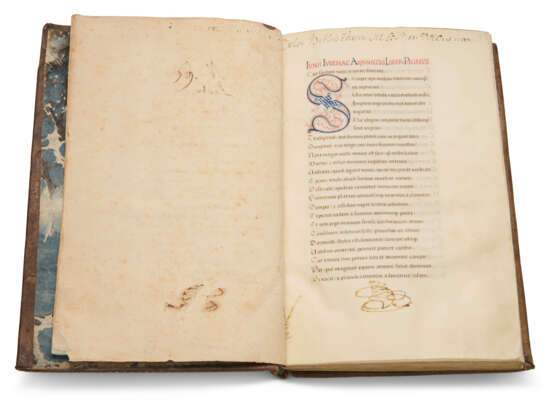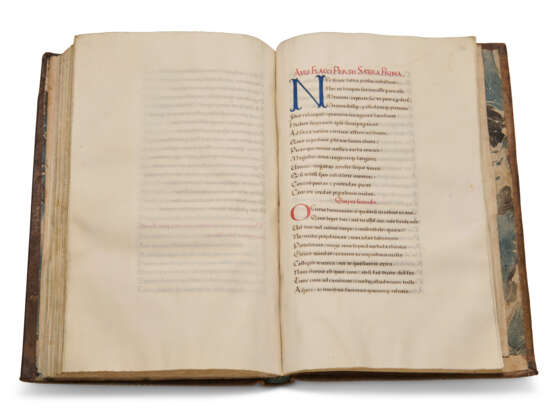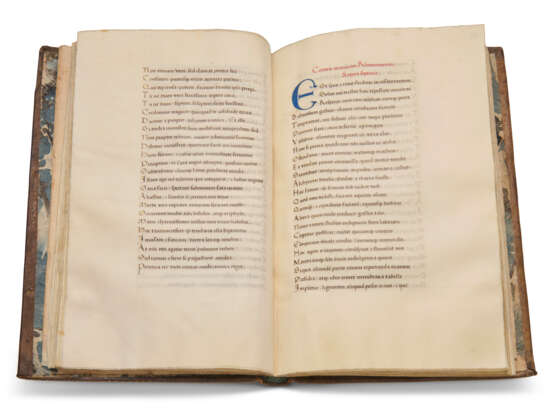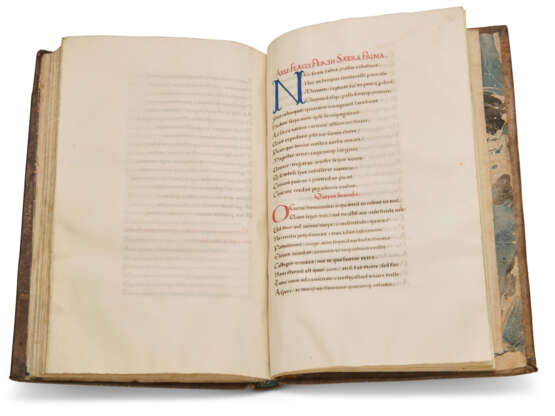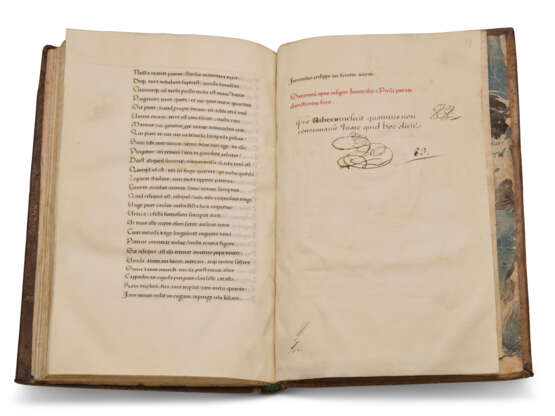ID 1450472
Lot 16 | Juvenal (c.55-128) and Persius (34-62)
Estimate value
£ 30 000 – 40 000
Satyrae, in Latin, decorated manuscript on vellum [Spain or Italy, second half 15th century]
A rare and early witness to the flowering of humanist studies in 15th-century Spain: a handsome manuscript of two important Classical texts, in a Spanish royal binding, from the libraries of Charles IV of Spain, his Napoleonic usurper Joseph Bonaparte and the Dukes of Wellington.
222 x 137mm. i (paper) + 89 + i (paper) leaves, complete, collation: 1-810, 99 (x a cancelled blank), modern foliation in pencil followed here, catchwords survive, 26 lines written in a gothic script with humanistic features, ruled space: 151 x 80mm, rubrics in red or blue, headings in red and blue, initials touched in yellow, red or blue initials opening each poem, a large foliate penwork initial opening Juvenal’s Satyrae, a large blue initial opening Persius’ Satyrae (a few light smudges, small repairs to the corners of ff.58-59, overall in excellent condition with wide, fresh margins). Bound in gilt-tooled Spanish mottled calf of c.1800 (royal binding of Carlos IV), gilt edges. Black fitted box.
Provenance:
(1) A near-contemporary inscription on f.89 reads: ‘ipse Ribera me fecit quamvis non consumaverit quare quid hoc dicitur’. The inscription, evidently by a Spanish hand, is not the main scribal hand, and is overwriting an earlier single-word inscription. In his 1976 study of the manuscripts seized from Joseph Bonaparte at Vitoria, Anthony Hobson suggests that the five classical texts present among the booty (our manuscript included) were of Italian origin, and that they reached the Colleges of San Bartolomé and Cuenca in Salamanca not long after their foundation in the early 16th century (A.R.A. Hobson, ‘Manuscripts captured at Vitoria’, Cultural Aspects of the Italian Renaissance, Essays in Honour of P.O. Kristeller, 1976, pp.485-496, this ms no 3, p.491). The 1979 Sotheby’s catalogue of the Wellington sale, though, describes the manuscript as Spanish. While we know that surviving Latin manuscripts of Juvenal and Persius are generally of Italian provenance, the princes and clerics of Castile, Aragon and Portugal took an early interest in Italian humanism and that Italian or Italianate works of Classical literature circulated at the courts of the Iberian Peninsula and Aragonese empire. The style of the initials is Iberian in flavour, but one tell-tale sign points to a Spanish (or at the very least not an Italian) scribe: the abbreviation for 'qui' in Italian manuscripts of the period has a short stroke crossing the descender of the 'q', which is not the case in this manuscript.
(2) Colegio Mayor de Cuenca: 18th-century ownership inscription on f.1 and shelfmark 'N.155.Poeta', but likely in its collections by the 16th century. Recorded in the catalogue of the College compiled by D. Andrés Navarro in 1782 (Madrid, BNE, MSS/2952, f.25).
(3) Charles IV of Spain (reigned 1788-1808). The manuscript was kept in the Palacio de Oriente: rebound there in its present royal binding (see Hobson, p.491). The bibliophile king had greatly increased the library left by Charles III; he used his royal authority to collect manuscripts from a wide variety of sources, an activity that intensified from c.1800.
(4) Joseph Bonaparte (1768-1844), made King of Spain from 1808 to 1813 by his brother Napoleon: his circular red inkstamp 'J.B.' and title 'Grand Electeur' on verso of first flyleaf. The volume was among ten pre-16th-century codices from the Spanish Royal Collections seized with Joseph’s coach and baggage train when he and the French troops fled the battlefield of Vitoria in 1813. Five of these were from the Colegio Mayor de Cuenca. Accounts of exactly what happened at Vitoria differ: the most dramatic has Joseph in the coach, being fired at by two aristocratic English officers, leaping out of the coach and onto a horse and so making his escape (Hobson, p.485). Possibly the coach was already stranded because the French were cutting horses loose from vehicles to make their escape. Veracity was probably not helped by the fact that some of the English needed to conceal their illegal looting of Joseph’s own looting (which included Jan van Eyck’s Arnolfini Double Portrait), before order was imposed and the remaining treasures were surrendered, as legitimate booty by the rules of war, to the future Duke of Wellington, in command of the English, Spanish and Portuguese forces that had crushingly defeated the French army. Wellington’s offer in the following year to return the treasures to the rightful King, Ferdinand VII, was formally refused in 1816 (Ferdinand’s ambassador, Fernàn Núñez, wrote that the King ‘touched by your delicacy, does not wish to deprive you of that which has come into your possession by means as just as they are honourable’, see Hobson, p.486).
(5) Arthur Wellesley, 1st Duke of Wellington and Duke of Ciudad Rodrigo (1769-1852): the military hero of the Peninsular War and the Battle of Waterloo went on to be Prime Minister 1828-1830 and briefly in 1834. His library was kept at Stratfield Saye, his country house presented by a grateful nation, and at Apsley House, his London home, now the Wellington Museum where paintings from Vitoria, notably by Velazquez, are exhibited. By descent to:
(6) Arthur Valerian Wellesley (1915-2014), 8th Duke of Wellington. A pencil note dated 1946 on the front flyleaf in the hand of the seventh duke, Gerald Wellesley, reads: ‘Mr. J. Wardrop, V. & A. Museum, considers that this MS. was written in Italy c. 1460’. Sold with seven other manuscripts from Vitoria (including the Vic Bible, sold at Christie’s 11 June 2024), Sotheby's 19 June 1979 lot 46, to:
(7) Nico Israel (1919-2002), prominent Amsterdam bookdealer and collector.
(8) Switzerland, private collection.
Content: Juvenal (Decimus Junius Juvenalis, c.55-128), Satyrae, ff.1-75; Persius (Aulus Persius Flaccus, 34-62), Satyrae, ff.76-89, ending: ‘Satyrarum opus insigne Juvenalis et Persii poetarum clarissimorum finit’.
The Satyrae of Juvenal are an exploration of the morality and perceived threats to the social continuity of the Roman way of life, and one of the final great compilations of the Golden Age of classical literature. Subjects range from life in the city of Rome (including the problems which ensue when a huge turbot is presented to the emperor, Satyra IV), to the vanity of human prayers; parents’ influence in education; the differences between men and beasts; and the privileges of the military. The six satires of Persius form the second text. They are preceded by the 14-line choliambic prologue by Persius himself, here numbered as the first satire. They deal with the debasement of literary taste; prayers and sacrifices; sloth; virtue in public men; the rarity of true freedom; and the poet's right to spend his own money.
Where Juvenal was not particularly popular in his own time (rarely – if ever – cited by early commentators), Persius was an instant hit; both, however, enjoyed immense popularity throughout the Middle Ages and their fortunes appear intertwined from around the 6th century onwards, with the works often appearing together in manuscript and, later, printed form: one of the principal manuscript sources containing both texts from which many subsequent medieval copies derive is Montpellier, Bibliothèque universitaire de médecine, Bibliothèque interuniversitaire de Montpellier, H 125, produced in Lorsch in the 9th century and once owned by Pierre Pithou, who used it for his edition of 1585.
| Place of origin: | Europe, Spain |
|---|---|
| Auction house category: | Medieval & renaissance manuscripts, Books and manuscripts |
| Place of origin: | Europe, Spain |
|---|---|
| Auction house category: | Medieval & renaissance manuscripts, Books and manuscripts |
| Address of auction |
CHRISTIE'S 8 King Street, St. James's SW1Y 6QT London United Kingdom | |
|---|---|---|
| Preview |
| |
| Phone | +44 (0)20 7839 9060 | |
| Buyer Premium | see on Website | |
| Conditions of purchase | Conditions of purchase |
